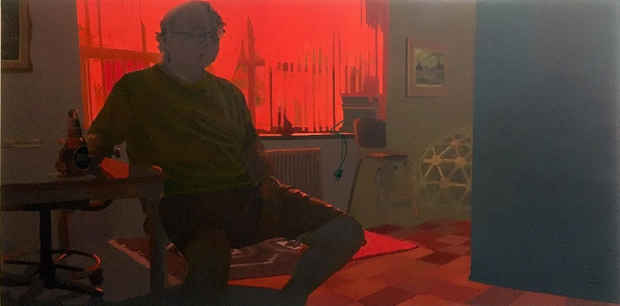Keiran Brennan Hinton “Extending the Day”
1969 Gallery

[Image: Keiran Brennan Hinton "Extending the Day" (2017) 48 x 96 in.]
This event has ended.
Through the Looking Glass: Q + As with Quang Bao and Keiran Brennan Hinton
Quang Bao: You carry a different book every week I see you, usually a novel. Would you say you are fascinated with narrative?
Keiran Brennan Hinton: I’m more interested in settings than narratives. I read a lot of fiction and hardly ever remember the events, but am always left with the feeling of being inside the physical space of the story, like the atmosphere in the living room in Yates’s Revolutionary Road or a Raymond Carver story. I want to think of painting in this way. The domestic figurative interiors become a moment in psychological space without beginning or end. They’re suspended in a thickness of silence.
QB: You lead a very social existence—you live and work with your former MFA classmates and you make regular visits home to Toronto. Family and community are deeply important to you. But there aren’t many people in your paintings.
KBH: I pay better attention in solitude, and the practice of painting becomes moment to train myself to look without assuming. The act of painting congeals into a record of the patient, motionless attitude of its making. Beyond painting, that practice of perception is an approach to the world outside the studio.
QB: What’s the difference between looking and seeing - from your painter’s viewpoint, I mean?
KBH: Looking seems patient while seeing sounds aggressive. Seeing suggests a truth, like one thing can only be seen the way you perceive it. “I see you” suggests that seeing equals understanding. I’m skeptical of that. Optically, how can we ever assume to see the world when the cones in our eyes only offer us a limited range of all colors that exist in a much wider spectrum? But I believe we can always look.
QB: Real people from your life do appear in the newest paintings and the exhibition slides back and forth between absence and presence. Maybe your ambition or artistic practice is growing bigger. Know what I mean?
KBH: The feeling of absence in some of the observational paintings opens a space someone could enter into. I want you to feel you’re by yourself but not alone. The absence is necessary so the looker can be present. When you listen, you have to withdraw in order to let words in. As in a mirror or reflection, you’re a participant in the image. I realized recently that there are no open eyes in any of the paintings and I started thinking about what it feels like to avoid eye contact.
QB: Looking into a window makes me melancholy for 10 seconds. I’m expecting to catch a glimpse of private life but I’m usually stuck with the leftover of whatever drama there might have been or a painting I wish the people inside would take down. Whereas looking out a window makes me instantly optimistic. Do you have a take on this in/out? Maybe it’s just me projecting the world as I want to see it.
KBH: Wow! Yes! I love that interpretation of out and in. A window is a point where a wall becomes permeable. At night, with the lights on, the interior of a house is on display through a window. How do we perform intimacy when we’re on view? Like a window, a room is also a frame. But at night when looking through a window from the inside of a room, the glass is mostly opaque and reflective. And all reflections are acknowledgements of existence and place. During the day, windows are places to daydream and an opportunity to imagine transportation, but windows are also grounding: they are structures that remind you of your body’s position on the floor. And at night, windows are instances of turning away, like Perseus’s shield. The window paintings are ways of looking into the figurative interiors, and also what the figures in the interiors are looking out at. Light is the only substance that passes freely through a window.
Keiran Brennan Hinton
b. 1992
Toronto, ON
Lives and works in New York, NY
Media
Schedule
from January 07, 2018 to February 25, 2018
Opening Reception on 2018-01-07 from 18:00 to 20:00